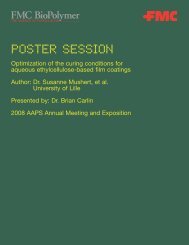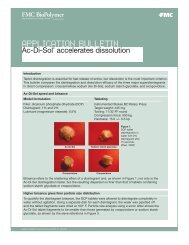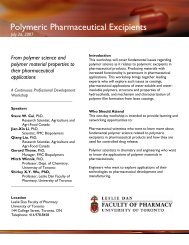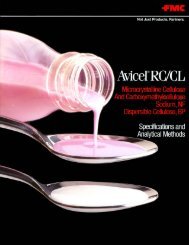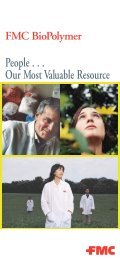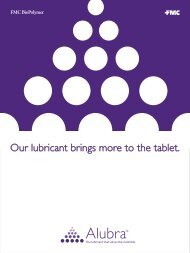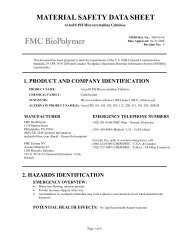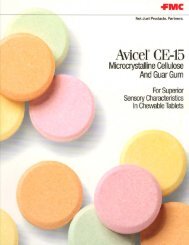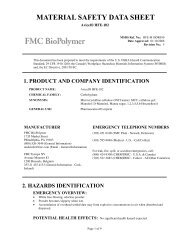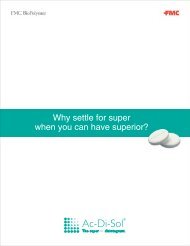LustreClear® LC-103 - FMC BioPolymer
LustreClear® LC-103 - FMC BioPolymer
LustreClear® LC-103 - FMC BioPolymer
You also want an ePaper? Increase the reach of your titles
YUMPU automatically turns print PDFs into web optimized ePapers that Google loves.
MATERIAL SAFETY DATA SHEET<br />
LustreClear <strong>LC</strong> <strong>103</strong><br />
MSDS Ref. No.: F18-26-8<br />
Date Approved: 01/27/2006<br />
Revision No.: 4<br />
This document has been prepared to meet the requirements of the U.S. OSHA Hazard Communication<br />
Standard, 29 CFR 1910.1200; the Canada’s Workplace Hazardous Materials Information System (WHMIS)<br />
and, the EC Directive, 2001/58/EC.<br />
1. PRODUCT AND COMPANY IDENTIFICATION<br />
PRODUCT NAME: LustreClear <strong>LC</strong> <strong>103</strong><br />
CHEMICAL NAME:<br />
CHEMICAL FAMILY:<br />
SYNONYMS:<br />
GENERAL USE:<br />
Microcrystalline cellulose / Carrageenan-Based Coating<br />
Carbohydrate, Polysaccharide<br />
Microcrystalline Cellulose (INCI name): MCC, cellulose gel;<br />
Carrageenan: Chondrus Crispus (Carrageenan)(INCI name),<br />
Carrageenin, Irish moss extract, Condrous extract<br />
Tablet coating<br />
MANUFACTURER<br />
<strong>FMC</strong> <strong>BioPolymer</strong><br />
1735 Market Street<br />
Philadelphia, PA 19<strong>103</strong><br />
(800) 526-3649 (General Information)<br />
<strong>FMC</strong> Europe NV<br />
Avenue Mounier 83<br />
1200 Brussels, Belgium<br />
+32 2 / 775 8311 (General Information - Brussels)<br />
EMERGENCY TELEPHONE NUMBERS<br />
(302) 451-0100 (<strong>FMC</strong> Plant - Newark, Delaware)<br />
(303) 595-9048 (Medical - U.S. - Call Collect)<br />
For leak, fire, spill, or accident emergencies, call:<br />
(800) 424-9300 (CHEMTREC - U.S.A. & Canada)<br />
(703) 527-3887 (CHEMTREC - All Other Countries)<br />
2. HAZARDS IDENTIFICATION<br />
EMERGENCY OVERVIEW:<br />
• White to off-white, free-flowing powder.<br />
• Powder becomes slippery when wet.<br />
• Accumulation of overhead settled dust may form explosive concentrations in air when disturbed and<br />
dispersed.<br />
• Contamination of product with strong acids will initiate accelerated hydrolysis.<br />
Page 1 of 9
LustreClear <strong>LC</strong> <strong>103</strong> (F18-26-8) Date: 01/27/2006<br />
POTENTIAL HEALTH EFFECTS: No adverse human effects known.<br />
3. COMPOSITION / INFORMATION ON INGREDIENTS<br />
Chemical Name CAS# Wt.% EC No. EC Class<br />
Microcrystalline cellulose 9004-34-6 232-674-9 Not classified<br />
Polyethylene glycol 25322-68-3 None Not classified<br />
Carrageenan 9000-07-1 232-524-2 Not classified<br />
4. FIRST AID MEASURES<br />
EYES: Flush with water for at least 15 minutes. If irritation occurs and persists, obtain medical<br />
attention.<br />
SKIN: Wash with plenty of soap and water. Get medical attention if irritation occurs and persists.<br />
INGESTION: Drink 1 or 2 glasses of water. Never induce vomiting or give anything by mouth to an<br />
unconscious person. If any discomfort persists, obtain medical attention.<br />
INHALATION: Remove to fresh air. If breathing difficulty or discomfort occurs and persists, obtain<br />
medical attention.<br />
NOTES TO MEDICAL DOCTOR: This product is expected to have low oral, dermal and<br />
inhalation toxicity. It is expected to be minimally irritating to the skin and eyes, and to be non-sensitizing to<br />
the skin. Treatment is symptomatic and supportive.<br />
5. FIRE FIGHTING MEASURES<br />
EXTINGUISHING MEDIA: Water<br />
FIRE / EXPLOSION HAZARDS: The accumulation of excessive dust of overhead<br />
structures may produce explosive concentrations when disturbed and dispersed.<br />
Page 2 of 9
LustreClear <strong>LC</strong> <strong>103</strong> (F18-26-8) Date: 01/27/2006<br />
FIRE FIGHTING PROCEDURES: For fires involving this material, do not enter any<br />
enclosed or confined fire space without wearing full protective clothing and self-contained breathing<br />
apparatus (SCBA) approved for firefighting. This is necessary to protect against the hazards of heat,<br />
products of combustion and oxygen deficiency. Do not breathe smoke, gases or vapors generated.<br />
FLAMMABLE LIMITS: Not applicable<br />
6. ACCIDENTAL RELEASE MEASURES<br />
RELEASE NOTES: Powder becomes slippery when wet. Maintain good housekeeping practices<br />
to minimize accumulation of settled dust, especially on overhead surfaces. Sweep up the spilled material<br />
and dispose of in accordance with the waste disposal method outlined in Section 13, "Disposal<br />
Considerations".<br />
7. HANDLING AND STORAGE<br />
HANDLING AND STORAGE: Use local exhaust or general dilution ventilation to control<br />
exposure to dust. Always use safe lifting techniques when manually moving containers, especially when<br />
shipping containers weigh more than 50 pounds (22.7 kg). Open container in well-ventilated area. Store in a<br />
dry area for product quality assurance. Avoid storing near strong acids (e.g., hydrochloric acid, sulfuric<br />
acid). Contamination of product with strong acids will initiate accelerated hydrolysis. Pallets should be<br />
stacked in a stable manner. Maintain adequate clearance from structural members and sprinklers. NFPA and<br />
U.S. OSHA state a minimum of 18 inches (45.7 cm) clearance shall be maintained between the top of<br />
storage and the ceiling sprinkler deflectors.<br />
8. EXPOSURE CONTROLS / PERSONAL PROTECTION<br />
EXPOSURE LIMITS<br />
Chemical Name ACGIH OSHA Supplier<br />
Microcrystalline<br />
cellulose<br />
10 mg/m 3 (TWA) 15 mg/m 3 (PEL) (total<br />
dust)<br />
5 mg/m 3 (PEL)<br />
(respirable fraction of<br />
dust)<br />
PERSONAL PROTECTIVE EQUIPMENT<br />
EYES AND FACE: Whenever airborne dust concentrations are high, appropriate<br />
protective eyewear, such as mono-goggles, should be worn to prevent eye contact.<br />
RESPIRATORY: Whenever dust in the worker's breathing zone cannot be controlled with<br />
ventilation or other engineering means, workers should wear respirators or dust masks approved by<br />
Page 3 of 9
LustreClear <strong>LC</strong> <strong>103</strong> (F18-26-8) Date: 01/27/2006<br />
NIOSH/MSHA, EU CEN or comparable certification organization to protect them against airborne<br />
dust.<br />
PROTECTIVE CLOTHING: No special clothing is required.<br />
GLOVES: Wear chemical protective gloves made of materials such as nitrile or neoprene.<br />
Thoroughly wash the outside of gloves prior to removal. Inspect regularly for leaks.<br />
COMMENTS:<br />
ADDITIONAL EXPOSURE LIMITS:<br />
Cellulose:<br />
Australia (TWA) 10 mg/m³<br />
Belgium (TWA) 10 mg/m 3 (inhalable dust)<br />
China (STEL): 25 mg/m³<br />
China (TWA): 10 mg/m³<br />
Hong Kong (TWA): 10 mg/m³<br />
Ireland (TWA): 10 mg/m³ (inhalable dust)<br />
Korea (TWA): 10 mg/m³<br />
New Zealand (TWA): 10 mg/m³ (respirable dust with no asbestos and less than 1% free silica)<br />
Singapore (PEL): 10 mg/m³<br />
Switzerland (TWA): 3 mg/m³ MAK (respirable)<br />
United Kingdom (STEL): 10 mg/m³ (total inhalable dust)<br />
United Kingdom (TWA): 10 mg/m³ (total inhalable dust); 4 mg/m³ (respirable dust)<br />
Polyethylene glycol:<br />
Germany (TWA): 1000 mg/m³ (inhalable fraction)<br />
Switzerland (TWA): 1000 ppm MAK<br />
9. PHYSICAL AND CHEMICAL PROPERTIES<br />
ODOR:<br />
Slight<br />
APPEARANCE:<br />
White to off-white, free-flowing powder<br />
AUTOIGNITION TEMPERATURE: 440 °C (824 °F) (± 2°C)<br />
BOILING POINT:<br />
Decomposes upon heating<br />
COEFFICIENT OF OIL / WATER: (Octanol/Water) Not applicable<br />
EVAPORATION RATE:<br />
(Butyl acetate = 1) Not applicable<br />
FLASH POINT:<br />
Not applicable<br />
FREEZING POINT:<br />
Not applicable<br />
MELTING POINT:<br />
Decomposes upon heating<br />
pH:<br />
(In solution) 5.0 - 8.0 (4% solids dispersion)<br />
SOLUBILITY IN WATER:<br />
(% by weight) Water dispersible<br />
Page 4 of 9
LustreClear <strong>LC</strong> <strong>103</strong> (F18-26-8) Date: 01/27/2006<br />
SPECIFIC GRAVITY:<br />
VAPOR DENSITY:<br />
VAPOR PRESSURE:<br />
(H 2 O = 1) Bulk density, 0.5 - 0.6 g/cc<br />
(Air = 1) Not applicable<br />
Not applicable<br />
10. STABILITY AND REACTIVITY<br />
CONDITIONS TO AVOID:<br />
STABILITY:<br />
HAZARDOUS DECOMPOSITION PRODUCTS:<br />
None known<br />
Stable<br />
Will produce oxides of sulfur on burning.<br />
11. TOXICOLOGICAL INFORMATION<br />
EYE EFFECTS: No data available for the product.<br />
MCC: Non-irritating (rabbit)<br />
Carrageenan: Minimally irritating (rabbit)<br />
Polyethylene glycol: Non- to minimally irritating (rabbit)<br />
SKIN EFFECTS: No data available for the product.<br />
MCC: Non-irritating (rabbit) Primary Irritating Index = 0/8.0<br />
Carrageenan: Non-irritating (rabbit)<br />
Polyethylene glycol: Non- to minimally irritating (human, rabbit)<br />
DERMAL LD 50 : No data available for the product.<br />
MCC: > 2,000 mg/kg (rat)<br />
Carrageenan: > 2,000 mg/kg (rabbit)<br />
ORAL LD 50 : No data available for the product.<br />
MCC: > 5,000 mg/kg (rat)<br />
Carrageenan: > 5,000 mg/kg (rat)<br />
Polyethylene glycol: > 50,000 mg/kg (rat, guinea pig, rabbit, mice)<br />
INHALATION <strong>LC</strong> 50 : No data available for the product.<br />
MCC: > 5.05 mg/l (4 h) (rat) Maximum attainable concentration - zero mortality<br />
Carrageenan: > 0.93 mg/l (4 h) (rat) Maximum attainable concentration - zero mortality<br />
SENSITIZATION: No data available for the product.<br />
MCC: (Skin) Non-sensitizing (guinea pig)<br />
Carrageenan: (Skin) Non-sensitizing (guinea pig)<br />
Polyethylene glycol: (Skin) Non- to minimally sensitizing (guinea pig)<br />
ACUTE EFFECTS FROM OVEREXPOSURE: No data available for the product.<br />
The ingredients in this product are expected to have low oral, dermal and inhalation toxicity. They are<br />
expected to be non-irritating or minimally irritating to the skin and eyes, and to be non-sensitizing to the<br />
skin.<br />
Page 5 of 9
LustreClear <strong>LC</strong> <strong>103</strong> (F18-26-8) Date: 01/27/2006<br />
CHRONIC EFFECTS FROM OVEREXPOSURE: No data available for the<br />
product. All of the ingredients in this product have low chronic toxicity when administered in the diet in<br />
lifetime feeding studies in laboratory animals. They are not expected to be mutagenic or carcinogenic.<br />
Microcrystalline cellulose is considered an inert dust, which is not toxic to the lung when exposures are<br />
properly controlled. A 90-day animal study showed no adverse effects when administered in the diet.<br />
Microcrystalline cellulose was negative in the Ames mutagenicity assay, and caused no chromosome<br />
damage in the mouse micronucleus assay. No adverse human effects are known.<br />
Carrageenan is not expected to have any significant effects. Reproductive toxicity and long term and<br />
lifetime feeding studies with carrageenan in laboratory animals were negative, as were results of<br />
mutagenicity studies.<br />
Polyethylene glycol (PEG) has low chronic toxicity when fed to rats in the diet for two years. Topical<br />
applications of this material should be avoided in burn victims and individuals with impaired renal<br />
function. PEG was not found to be genotoxic, mutagenic or teratogenic in a battery of tests, and was not<br />
found to have reproductive effects. PEG showed no adverse effects in a 5-week, 1 year and a 2 year<br />
subchronic study. A 90-day study in rats showed no effects at up to 4 and 16% in the diet; however, minor<br />
kidney effects at >/= 80 mg/kg/day and some testicular effects at >/= 230 mg/kg/day were noted.<br />
CARCINOGENICITY:<br />
NTP:<br />
IARC:<br />
OSHA:<br />
OTHER:<br />
Not listed<br />
Not listed<br />
Not listed<br />
Not Listed (ACGIH)<br />
12. ECOLOGICAL INFORMATION<br />
ENVIRONMENTAL DATA: No data available for the product. The components of this<br />
formulation are not expected to have significant environmental effects. Microcrystalline cellulose is<br />
inherently biodegradable in soil. It biodegrades in soil at a rate comparable to corn starch.<br />
ECOTOXICOLOGICAL INFORMATION: No data available for the product.<br />
Carrageenan is an extract of seaweeds of the class Rhodophyceae (red seaweeds), and is not expected to<br />
have significant toxicity to aquatic organisms.<br />
Microcrystalline cellulose:<br />
96-hour <strong>LC</strong> 50 > 100%, Saturated solution; NOEC = 100% (rainbow trout)<br />
48-hour <strong>LC</strong> 50 > 100%, Saturated solution; NOEC = 100% (daphnia)<br />
96-hour EC 50 > 100%, Saturated solution; NOEC = 12.5% (algae)<br />
Page 6 of 9
LustreClear <strong>LC</strong> <strong>103</strong> (F18-26-8) Date: 01/27/2006<br />
13. DISPOSAL CONSIDERATIONS<br />
DISPOSAL METHOD: No special disposal methods are suggested. It is the user's responsibility<br />
to comply with all applicable local, state, and federal laws, rules, regulations and standards.<br />
14. TRANSPORT INFORMATION<br />
U.S. DEPARTMENT OF TRANSPORTATION (DOT)<br />
MARINE POLLUTANT:<br />
ADDITIONAL INFORMATION:<br />
None<br />
Not listed in Title 49 of the U.S. Code of<br />
Federal Regulations as a hazardous<br />
material.<br />
National Motor Freight Classification Item<br />
71390, Flour Cellulose, Edible<br />
INTERNATIONAL MARITIME DANGEROUS GOODS (IMDG)<br />
ADDITIONAL INFORMATION:<br />
Not applicable<br />
ADR - EUROPEAN AGREEMENT CONCERNING THE<br />
INTERNATIONAL CARRIAGE OF DANGEROUS GOODS BY ROAD<br />
ADDITIONAL INFORMATION:<br />
Not applicable<br />
INTERNATIONAL CIVIL AVIATION ORGANIZATION (ICAO) /<br />
INTERNATIONAL AIR TRANSPORT ASSOCIATION (IATA)<br />
ADDITIONAL INFORMATION:<br />
Not applicable<br />
OTHER INFORMATION:<br />
Canada (TDG) : Not applicable<br />
Page 7 of 9
LustreClear <strong>LC</strong> <strong>103</strong> (F18-26-8) Date: 01/27/2006<br />
15. REGULATORY INFORMATION<br />
UNITED STATES<br />
SARA TITLE III (SUPERFUND AMENDMENTS AND REAUTHORIZATION ACT)<br />
SECTION 302 EXTREMELY HAZARDOUS SUBSTANCES (40 CFR 355, APPENDIX A):<br />
Not listed<br />
SECTION 311 HAZARD CATEGORIES (40 CFR 370):<br />
None<br />
SECTION 312 THRESHOLD PLANNING QUANTITY (40 CFR 370):<br />
The Threshold Planning Quantity (TPQ) for this product, if treated as a mixture, is 10,000 lbs;<br />
however, this product contains the following ingredients with a TPQ of less than 10,000 lbs.:<br />
None<br />
SECTION 313 REPORTABLE INGREDIENTS (40 CFR 372):<br />
This product does not contain any toxic chemicals subject to the reporting requirements of<br />
Section 313, Title III of the SARA (Superfund Amendments and Reauthorization Act) of<br />
1986.<br />
TSCA (TOXIC SUBSTANCE CONTROL ACT)<br />
TSCA INVENTORY STATUS (40 CFR 710):<br />
Listed (components)<br />
CANADA<br />
WHMIS (WORKPLACE HAZARDOUS MATERIALS INFORMATION SYSTEM):<br />
Not a controlled product under the Canadian Workplace Hazardous Materials Information System<br />
(WHMIS).<br />
Chemical Name:<br />
Polyethylene glycol<br />
Hazard Classification / Division: Class D, 2B<br />
Domestic Substance List: Yes (components)<br />
E NUMBERS:<br />
E 460 (microcrystalline cellulose)<br />
E 407 (carrageenan)<br />
INTERNATIONAL LISTINGS<br />
MCC<br />
Australia (AICS): Listed<br />
China: Listed<br />
Japan (ENCS): (8)-568<br />
Korea: KE-05339<br />
Philippines (PICCS): Listed<br />
Carrageenan<br />
Australia (AICS): Listed<br />
Page 8 of 9
LustreClear <strong>LC</strong> <strong>103</strong> (F18-26-8) Date: 01/27/2006<br />
China: Listed<br />
Philippines (PICCS): Listed<br />
Polyethylene glycol<br />
Australia (AICS): Listed<br />
China: Listed<br />
Japan (ENCS): (2)-442; (7)-129; (8)-429<br />
Korea: KE-20228<br />
Philippines (PICCS): Listed<br />
16. OTHER INFORMATION<br />
NFPA<br />
Health 0<br />
Flammability 1<br />
Reactivity 0<br />
Special<br />
None<br />
No special requirements<br />
NFPA = National Fire Protection Association<br />
Degree of Hazard Code:<br />
4 = Extreme<br />
3 = High<br />
2 = Moderate<br />
1 = Slight<br />
0 = Insignificant<br />
REVISION SUMMARY:<br />
This MSDS replaces Revision #3, dated April 29, 2004.<br />
Changes in information are as follows:<br />
Section 1 (Product and Company Identification)<br />
Section 15 (Regulatory Information)<br />
Section 16 (Other Information)<br />
LustreClear and <strong>FMC</strong> <strong>BioPolymer</strong> Logo - <strong>FMC</strong> Trademarks<br />
© 2006 <strong>FMC</strong> Corporation. All Rights Reserved.<br />
Page 9 of 9




